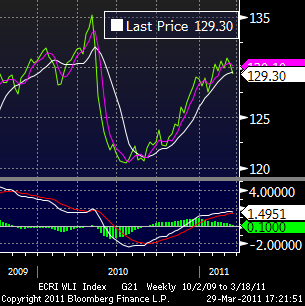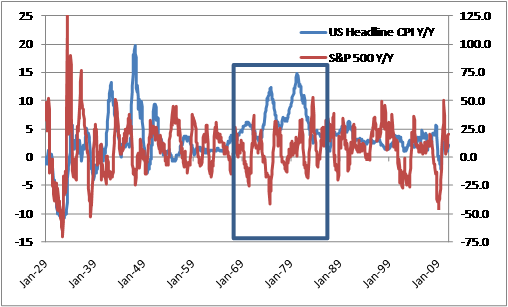Any critical analysis of the period leading up to the GFC lays some of the blame of the bubble that built at the length of time that Chairman Greenspan left rates in the US incredibly low after the September 11 attacks. Certainly there were many other and much more important drivers of the debacle that led to the malaise we in Australia now call the GFC but free money helped set up the preconditions for the real deterioration in rationality, morality and good sense.
Some may disagree with this hypothesis as there were many other drivers which ultimately seem more important but I think that Central Bankers view this period of low interest rates as analogous to what we have now and like old Generals fighting the last war they are worried that they are setting up just another bubble. This time in commodities and other risk assets perhaps but a bubble nonetheless.
Last year Jeremy Grantham accused the Fed of “blowing bubbles” after it put in QE2 but I think that comments by Comstock Partners back in February are as good an example of this line of thought as you’ll see (my bolding).
“It seems incredible that the Fed is creating the third bubble within 11 years, but that is what is underway. In the late 1990s the Fed kept the pedal on the gas and helped engender the dot-com bubble that collapsed with a 75% decline in the Nasdaq and 50% in the S&P 500. To prevent the economy from correcting the imbalances created in that era, the Fed kept the funds rate at 1% for an extraordinarily long time, thereby fostering the backdrop for the historic housing boom that also collapsed and came dangerously close to bringing down the global economic and financial system…
The Fed jump-started the stock market with two rounds of massive easing commonly known as QE1 and QE2. Not coincidentally, the market bottomed in March 2009 just as QE1 got underway. When that program, consisting of the Fed’s purchase of $1.5 trillion of Treasury Bonds and mortgages, ended in April 2010, stocks dropped 17% in a few months. When stocks declined and the economy faltered Chairman Bernanke, at a late August meeting in Jackson Hole, announced the Fed’s intentions to institute QE2, a program to buy $600 billion of 2-to10-year Treasury notes by June 30, 2011. Since that time the market began rising and hasn’t stopped since. Notably the program, which actually began in October is pumping about $3.4 billion into the economy and assets every workday of the week.
The stated purpose of QE2, as outlined in a Washington Post op-ed column by Bernanke, is to pump up asset values with the hope that it would feed into the economy and to lower mortgage rates in an effort to aid the housing market. QE2 did goose the stock market, but appears to be failing miserably on a number of other fronts. It has not helped housing, which is still in the doldrums, and has only marginally helped employment. Furthermore the policy has created a lot more commodity inflation with higher prices for energy, food, cotton and a wide number of other items. It has led to inflation in emerging nations that have begun tightening money to slow down their economies. It has also caused a rise in long-term bond and mortgage rates, contrary to initial expectations.”
I think that this recognition has grown and the commodity based inflation in particular and the impact of same has awoken many global policy makers in both the developed and developing world of the risks to the global economy if this free money period persists for too long. Importantly I believe that the chances of the end to QE2, and certainly that QE3 is a non-starter, has risen materially over the past 3 months and that this posses a big risk for markets at the moment drunk on free money. I have a chart below which shows the impact of QE2 on the S&P 500 and agricultural commodities, I could add the AUD and other punting style assets as well. I’d argue that Bernanke has targeted stocks in order to keep American’s heads up until the real economy gets on a more even keel.

Houses and Holes has warned me of trying to call a “liquidity based reversal in markets” and this is sage advice as the last bubble period showed. But my major point is that I’m not trying to call this but rather highlight the risks to markets around the increasing move toward a hike in interest rates, coming from fear of inflation, at a time when the market and economies are not ready will undermine confidence in risk assets and thus increase downside risks and volatility.
I have a personal view that the belligerence of the inflation fighters at the ECB, their ignorance of the sovereign and structural issues of Europe and possibly even the nascent hawkishness at the Fed, as they fight echoes of the Weimar Republic and Greenspan’s bubble respectively, puts me on notice that rates may be hiked sooner than the market is anticipating and, crucially, QE3 may not materialise. Others have warned me that this may actually be seen a s a good sign if the economies are on a more sustainable footing and that markets may take this as a positive. But the economy is not more sustainable whatever the hype and hope. Just ask the 44 million Americans on food stamps, the householders watching their equity tank AGAIN, the wage earners in the US suffering falls in 4 of the last 6 months.
Indeed just like the Fed’s hope that QE2 would drive US long rates lower this notion that markets may find the withdrawal of stimulus positive seems to me ungrounded and may find little traction because the market is a discounting machine of some repute. That is, if the economies are deemed as too weak to deal with higher rates, or higher rates are a result not of economic strength but of fear of inflation then risk assets may get sold as a result of the downgrading of future growth not acceptance that it is on a better footing.

For example the chart above is the updated path of the bounce in Industrial Production in the US after the recent annual revision. Not terrible and the trend is still intact but not as strong as previously assumed. Add in the ECRI Weekly Index which tracks leading indicators of the US economy as we see is rolling over below below and we could argue that this, along with many global PMI’s is signalling that the global growth sweet spot is behind us. Even if the inflationary pulse is not.

But even as the US’s sweet spot passes we are hearing from various Fed players that the need for “monetary accommodation” may be nearing an end. I think this could pose a clear and present danger to the current market free money paradigm which, along with musing on interest rate hikes from the ECB, could derail market ebullience sometime in the next few months particularly if this is against a fading economic pulse.

The chart above is my stylisation of the risks to markets performance from higher interest rates as a result of inflation not growth. This chart shows the year on year growth of inflation versus year on year moves in the S&P 500 (as the best indicator of US Equity markets and in today’s jaundice parlance – risk assets). The box is the 70’s which potentially is the closest thing we have market and economically to what might happen in the next year or two. Not my base case but a concern of the “old generals at the ECB and Fed.
So back to the original catalyst for this blog. I saw a blog posted by Dian L Chu on Zero Hedge overnight which looked at a potential early end to QE2 and what might happen. “Blood in the streets” was the title of the blog. Chu quotes St Louis Fed president Bullard’s comments recently that
If the economy is as strong as I think it is, then I think it may be reasonable to send a signal to markets that we’re going to start withdrawing our stimulus, and I’d start by pulling up a little bit short on the QE2 program… We can’t be as accommodative as we are today for too long, we’ll create a lot of inflation if we do that.
And goes on to say that:
…it seems that QE2 will get a serious review during the Federal Reserve`s April meeting, and could be cut short by two months in order to send financial markets the message that they will not allow inflation to get out of control.
Markets have discounted low rates and quantitative easing into their models. Under this analysis the discount factor for any given cash flow is lower and thus the net present value of those cash flows is much higher. Indeed if we view equity dividends as a perpetuity and discount them by zero interest rates then we effectively get an almost infinite valuation. So an increase in interest rates which increases the discount factor which by implication decreases the value of those cash flows associated with an asset and thus their present value.
Add in an economy that is not yet able to carry the weight of market expectations on growth and income generation and we have a set up for a big unwinding of the post March 2009 bounce.
I don’t know when the QE’s will end nor indeed if there will or won’t be a QE3. But my sense is the risks of early withdrawal are rising and I do understand the sentiment that central bankers feel a need to move on rates to protect their economies from inflation and the risk of a de-anchoring of inflation expectations even though I’m not convinced that we are nearing an inflationary spiral. History tells us though that even after a mess like the one we’ve just experienced eventually we’ll get an inflation uptick but it seems a little early and aggregate demand is not yet strong enough globally. So if Central Bankers feel the need to take away the punchbowl earlier than the market expects or the economy can bear I’m fairly sure we will see market ructions erupt. Have a read of the blog on zerohedge I think it’s worth the time as it sets out the risks and set up of the current market quite nicely.
But to round things off with one of my favourite North American Economists/Strategist Dave Rosenberg of Gluskin Sheff. Last week Rosenberg wrote a piece on how markets dealt so well with all the ructions of the past few months. He says:
Risk appetite is still being whetted by all the talk of “containment” — basically, that the nuclear damage in Japan is now being “contained” and that the tensions in the Middle East will be “contained” to Libya and that the oil price reflects all the problems related to supply constraints in the region. The last time we heard the word “contained” used so much was back in 2007 regarding the turmoil in the U.S. housing and mortgage market. As was the case then, it took a great deal to really break the momentum and the “buy-the-dips” mentality not only continues unabated, as it did the fall of that year, but investors are once again being handsomely rewarded for doing so. But the outlook remains fraught with risk, notwithstanding the sanguine approach being taken by the consensus of strategists as well as the majority of economists.
The withdrawal of QE and increase in interest before the market and economy are ready is a clear and present danger to markets at the moment. Many are far too sanguine. My portfolio has some options cover in place.